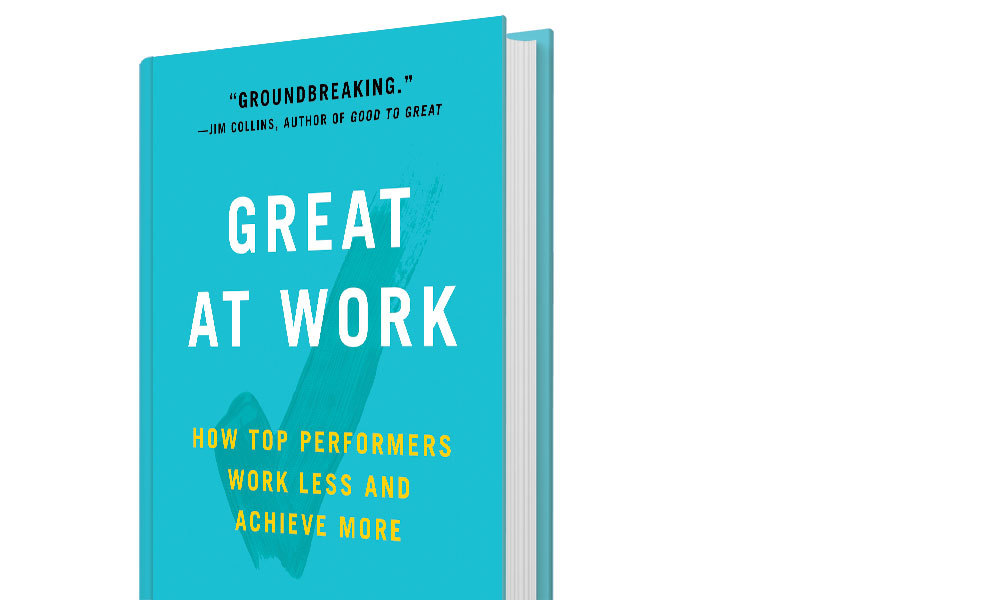
Books: Work Smarter
What makes a high performer tick? Morten Hansen's Great At Work breaks things down.
Great at Work: How Top Performers Work Less and Achieve More
By Morten Hansen; Simon & Schuster; 320 pages; $29.99
Morten Hansen, coauthor with Jim Collins of the bestselling Great By Choice, redirects his longtime scrutiny of organizational performance to outstanding individual employees in his latest, Great at Work: How Top Performers Work Less and Achieve More.
What do high performers do that others don’t, especially when the usual “work smarter, not longer” response skips the vital how-to’s? That gap inspired Hansen’s five-year study of 5,000 managers and professionals, which revealed seven “work smarter practices” that can improve anyone’s performance by up to 66 percent.
The study found the biggest boost to performance when workers were “doing less and then obsessing.” Obsessing is key, according to Hansen, and the payoff is sizable: 25 percent higher performance than colleagues trying to execute numerous priorities.
Of particular interest is the work-smarter practice called looping, which swipes at the 10,000-hours-to-mastery mantra. “A whopping 74 percent of top performers in our dataset constantly reviewed their work [or looped] … to learn and improve,” demonstrating that “quality learning” trumps quantity of practice, Hansen writes. Effective looping includes regular peer feedback, chunking of tasks, and a laser focus on learning one skill.
Other habits of high performers involve creating safe and unifying cultures for candor and debate (fight and unite), matching “passion with purpose” (P-squared), inspiring diverse advocates for your ideas (forceful champions), and choosing to collaborate only when the business case demands it (disciplined collaboration).
Use the quizzes and assessments to speed yourself to stardom.

Dollars and Sense: How We Misthink Money and How to Spend Smarter
By Dan Ariely and Jeff Kreisler; HarperCollins Publishers; 288 pages; $27.99
In his continuing exploration of the behavioral impacts of our irrational brains, economist Dan Ariely teams with “financial comedian” Jeff Kreisler to determine how we contort financial decision-making and why even coaching is pointless unless natural “mental shortcomings” are exposed and retrained. Those inadequacies make up parts one and two of the book, where the authors blend economic and neuroscience terms to explain the brain quirks that mess with our spending, saving, and investing habits.
The authors also show why brain function makes us vulnerable to behavior-savvy marketers and new technologies that let us ignore or speed the drainage of our accounts. Part three calls us to action, urging design of systems that pause and correct gut behaviors and better tie money to value.
Includes good suggestions on sparking higher employee investment in employer retirement plans.

Hit Makers: The Science of Popularity in an Age of Distraction
By Derek Thompson; Penguin Press; 368 pages; $28
If you’re interested in brand boosting, take inspiration from the new tome by Senior Editor Derek Thompson of The Atlantic. With heavy research but engaging insider stories, Thompson celebrates the making of cultural hits and flops such as Game of Thrones and Fifty Shades of Grey, while debunking myths around “going viral” and why we simultaneously love and hate stuff.
His journey foreshadows a branding future with mobile everything, a “more global stage with many narrow spotlights,” and a growing need to know “the audience of your audience.” But Thompson gently reminds us that “people’s basic needs are complex but old. They want to feel unique and also to belong; to bathe in familiarity and to be provoked a little; to have their expectations met, broken, and met again.”
Add to your it list.






Comments